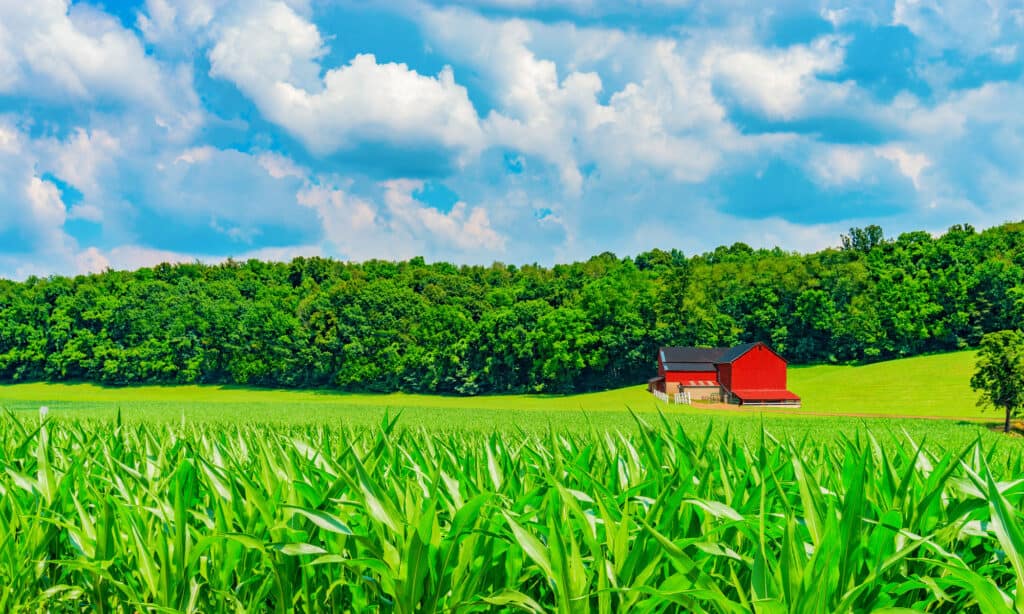If you have ever driven through Indiana, you have probably seen enormous corn and soybean fields and wide cattle pastures. Maybe you have passed grain bins, equipment shacks, as well as dairy, hogs, and poultry barns. Farming significantly contributes to Indiana’s economy, accounting for an estimated $31.2 billion. Land is a potential cash cow for Indiana farmers, with plenty of opportunities for those seeking to capitalize on the rising property values.
According to the Indiana State Department of Agriculture, the state has over 56,000 farming operations, with an average farm size of 264 acres. For reference, one football field is around 1.32 acres in size, indicating that the average Indiana farm is approximately the size of 200 football fields. But who is the largest land owner in the Hoosier State? This article uncovers everything you need to know about the largest land owner in Indiana.
Who Is the Largest Land Owner in Indiana?

Kip Tom, the owner of Tom Farms, is the largest private landowner in Indiana.
©U.S. Department of State / public domain – License
Tom Farms, owned by mega-farmer Kip Tom, is the largest land owner in Indiana, with a total of 21,000 acres of land comprised of 17,000 acres in Indiana and 4,500 acres in Argentina. Tom Farms is a multi-generational family business based in the rich grasslands of North Indiana. The farming company has become a global agricultural production, sales, and service firm and an industry leader.
Agriculture is a highly unpredictable industry by nature. With creativity, meticulous planning, and quick thinking, Tom Farms assures the shipment of more than 30 million pounds of seed corn, 100 million pounds of corn, and 13 million pounds of soybeans each year. Tom Farms utilizes superior technology, round-the-clock vigilance, and flawless execution, maximizing the production efficiency of every single acre.
Who Is Kip Tom?
From 2019 to 2021, Kip E. Tom was the United States Ambassador to the United Nations Agencies for Food and Agriculture and the Chief of the United States Mission to the UN Agencies in Rome.
Six food and agricultural development agencies are under the United Nations, and the United States is heavily involved with the Food and Agriculture Organization (FAO). As a result, there are State Department political and economic officials and staff for USDA and US International Development Agency. In 2016, Kip Tom ran in the Republican primary for Indiana’s third congressional district against Jim Banks, finishing “a close second.”
How Did Tom Farms Start?
Kip’s parents, Everett and Marie Tom, started farming with a 240-acre crop and cattle operation in 1948, with the present family members being active in the business since then. Kip started farming alongside his parents in 1974, and the farm expanded to 700 acres fairly soon. The utilization of irrigation on their sandy loam marked the beginning of their transformation from a traditional Midwestern farm to a value-added business. For the first time ever, the Toms’ crops were practically “drought-proof.”
Then, in 1985, they were given the opportunity to start growing seeds for Pioneer. That partnership flourished as Tom Farms not only raised corn with Pioneer but also assisted them in solving their “seed problems” with creative solutions. As a result, irrigation and Pioneer became early technologies and an alliance that allowed the Toms to distinguish themselves as their firm evolved. The Pioneer relationship lasted until 2006.
Since then, the firm has expanded to encompass six families. Everett and Marie are still involved with the firm. Kip is Tom Farms LLC’s managing member, while his sister, Melissa Gerber, is the office manager and controller. Kip’s five children are also involved in the business, including sons Kyle and Kris, daughter Kassi Rowland and her husband, Greg Rowland. Kyle and Greg split crop production management tasks, and Kassi assists Melissa with office and financial administration.
Is Farming a Risky Business?

Risk is an important aspect of the farming business.
©Patricia Elaine Thomas/Shutterstock.com
Farming has always been a high-risk endeavor. Weather, yields, pricing, government regulations, global markets, and other factors affecting farming can all cause large changes in agricultural revenue. Production risk, price or market risk, financial risk, institutional risk, and human or personal risk are the five general forms of risk. Risk management entails selecting solutions that limit the financial consequences of such uncertainty.
Is Foreign Ownership Allowed in Indiana?
A state senator in Indiana sought to prohibit foreign ownership of agricultural land in the state, but his bill was altered to allow foreign ownership of up to 320 acres of land planted with crops.
Senate Bill 388, authored by Sen. Mark Messmer, was approved by a vote of 47-2 in the Senate. According to the bill, starting July 1, a “foreign business entity” may not purchase agricultural land in Indiana unless the site will be used for non-farming purposes.
Messmer agreed to revise the measure following a committee hearing before the Senate Committee on Agriculture on Jan. 18, during which officials from the Indiana Chamber of Commerce, the Indiana State Poultry Association, and the German-owned business Bayer spoke and expressed concerns. The bill was adjusted to only apply to cropland, not land used for poultry or egg production, dairy farming, grazing, or growing fruit “or other horticultural crops.” It was also changed to allow foreign companies own up to 320 acres of agricultural land in Indiana, but nothing more, and to exempt all agricultural land used for research or scientific purposes.
Indiana’s Top Farm Products
Agriculture is very important in Indiana. The following is a list of its most important crops with 2020 values: 1) Corn – $4.4B (4th in the US); 2) Soybeans/edamame – $3.8B; 3) Hay and Halage (grass silage) $230.6M; 4) Wheat – $92.8M (6th in the US); 5) Melons – $46.9M (6th in the US); 6) Pumpkins – $16.4M; 7) Mint – $4.6M (4th in the US);
In addition, Indiana lists hogs as its most valuable livestock product followed by milk, beef cattle, and eggs. Other livestock popular in Indiana are turkeys, ducks, and sheep.
In the produce area, Indiana’s top vegetable is the tomato (actually a fruit), but the state also grows a lot of cucumers, onions, potatoes, snap beans, and sweet corn. In the fruit category, apples, blueberries, and watermelons are popular commercial crops.
The photo featured at the top of this post is © Alena Mozhjer/Shutterstock.com
Sources
- World Population Review, Available here: https://worldpopulationreview.com/state-rankings/largest-landowners-by-state
- Wikipedia, Available here: https://en.wikipedia.org/wiki/Kip_E._Tom
- , Available here: https://agribusiness.purdue.edu/wp-content/uploads/2019/08/modern-global-farmer-case-study-2011.pdf
- U.S. Department of Agriculture, Available here: https://www.ers.usda.gov/topics/farm-practices-management/risk-management/risk-in-agriculture
Thank you for reading! Have some feedback for us? Contact the AZ Animals editorial team.






